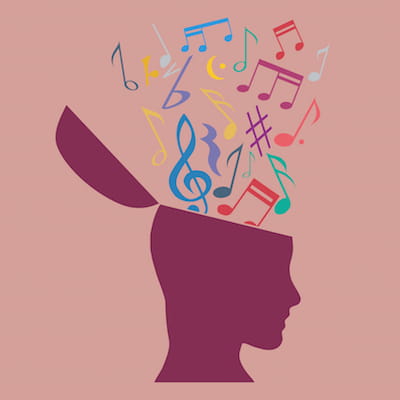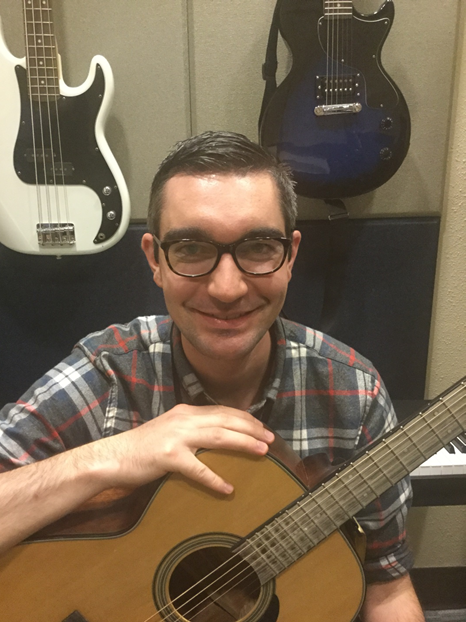What is music therapy and how is it used in a hospital?
I am a music therapist in a pediatric hospital and a hospital for women and babies. That is often what I say when I’m asked my occupation by friends and family. While most people generally understand what goes on in a hospital, it can be difficult to conceptualize what music therapy is and how it functions in the medical setting. Follow-up questions and comments from those unfamiliar with music therapy often include: “I didn’t know that was a thing” and “So you play music for patients in the hospital?” My answer is yes, it is a thing, but it is so much more than just playing music for hospitalized individuals.
Music is a universal phenomenon that permeates our everyday experience. Most people recognize the innate nature of music and its role in our lives, but the concept of integrating music experiences with therapy can be elusive. As a music therapist, I must constantly evaluate the mechanisms by which music steers therapeutic change. Fortunately, music therapy is a research-based field with several books, peer-reviewed journals and articles, and a large cohort of scientists dedicated to studying and teaching its practice. I currently conduct music therapy research at Winnie Palmer Hospital, so I can safely say that music therapy is not just about playing music for patients - there is a large scientific foundation for the methods and techniques music therapists employ.
The marriage of music and therapy
 One of the most difficult things to understand for a music therapy outsider is that just because you may find certain music activities therapeutic, the experience may not fit the definition of “therapy.” For example, a musician playing harp on the hospital floor may be incredibly soothing for those in earshot. However, this musician (usually referred to as a music practitioner) lacks the type of formal education and training that a music therapist has. A music therapist must have a deep understanding of how to perform and manipulate music for therapeutic benefit, but simultaneously be a competent therapist. Being a therapist means providing a unidirectional service (therapist helping the patient and not the other way around) wherein an expertise is required to deliver intervention to promote health. Music therapists are skilled in the art of therapeutic conversation, and the most qualified and well-informed clinicians when it comes to using music during therapy. This doesn’t mean other heath professionals can’t or shouldn’t use music in their practice. However, there are distinct music therapy interventions, just like there are techniques unique to physical therapy and psychotherapy.
One of the most difficult things to understand for a music therapy outsider is that just because you may find certain music activities therapeutic, the experience may not fit the definition of “therapy.” For example, a musician playing harp on the hospital floor may be incredibly soothing for those in earshot. However, this musician (usually referred to as a music practitioner) lacks the type of formal education and training that a music therapist has. A music therapist must have a deep understanding of how to perform and manipulate music for therapeutic benefit, but simultaneously be a competent therapist. Being a therapist means providing a unidirectional service (therapist helping the patient and not the other way around) wherein an expertise is required to deliver intervention to promote health. Music therapists are skilled in the art of therapeutic conversation, and the most qualified and well-informed clinicians when it comes to using music during therapy. This doesn’t mean other heath professionals can’t or shouldn’t use music in their practice. However, there are distinct music therapy interventions, just like there are techniques unique to physical therapy and psychotherapy.
How does music work during therapy?
People constantly use music to alter their state, help reflect on their mood, motivate a workout, socialize with others, or just pass the time. Music on its own has immense power to influence how we feel and behave. It is a music therapist’s job to contain that power and administer elements of music to enact clinical therapeutic change. One way we can conceptualize how this works is by the music therapist asking: Am I using music as therapy or music in therapy. There is a subtle, but important difference.
Music as therapy: This is when music is the primary medium and agent for therapeutic change. It is the music and its tailored qualities that exert influence on the patient. Personal relationships and the use of other arts or modalities are seen as the context that focuses the music’s potential.
Music in therapy: This is when the music provides context for other therapeutic factors such as the clinician-patient relationship or other therapeutic modalities. In this case, music is not necessarily the driving factor of change, but still enhances the overall treatment.
Here are some examples to help you understand the difference:
Music as therapy: A music therapist (MT) implements live music with guitar while guiding the patient in imagery. Guitar chords are arpeggiated (i.e., strummed one string at a time) upwards during the patient’s breathing in, with downward arpeggiation during exhales. The tempo of the strumming is entrained to the tempo of the patient’s breathing and gradually slowed to cue relaxation and help manage pain.
Music in therapy: The MT determines the preferred music of a patient. This music is facilitated live with singing and guitar, and the patient is tasked with actively listening and identifying lyrics meaningful to him. Following the song, the MT engages the patient in supportive conversation, helping the patient gain insight into his thoughts and develop positive cognitive coping skills.
 There are many ways music can be used to promote health, and music therapists provide an evidence-based approach. Music therapists target social, emotional, physical, and cognitive goals through structured music experiences. We may provide groups in which patients learn prosocial interactions through cooperative instrument play, help patients write music to process their emotional state, engage patients in drumming exercises to promote movement for rehabilitation purposes, or provide regimens of live and recorded music for infants to help develop their ability to discriminate sounds and strengthen neurologic auditory pathways.
There are many ways music can be used to promote health, and music therapists provide an evidence-based approach. Music therapists target social, emotional, physical, and cognitive goals through structured music experiences. We may provide groups in which patients learn prosocial interactions through cooperative instrument play, help patients write music to process their emotional state, engage patients in drumming exercises to promote movement for rehabilitation purposes, or provide regimens of live and recorded music for infants to help develop their ability to discriminate sounds and strengthen neurologic auditory pathways.
Also, music therapy may look different depending on the setting. My explanation comes from a medical perspective, but many music therapists work in special needs schools, geriatric centers, rehabilitation, private practice, mental health, and forensic settings.
While you may see me or the other music therapists at Orlando Health carrying around a guitar or other instruments, this does not mean we are here to entertain staff or hospital guests. Entertainment is one function of music, but music can be used for much more. Like the other therapists in the hospital, we are here to provide a clinical service, to use our expertise in a specific field to promote health. Music is a powerful stimulus. Understanding how to manipulate music for therapeutic benefit is a cornerstone of music therapy practice.
For more information on music therapy visit https://www.musictherapy.org/










